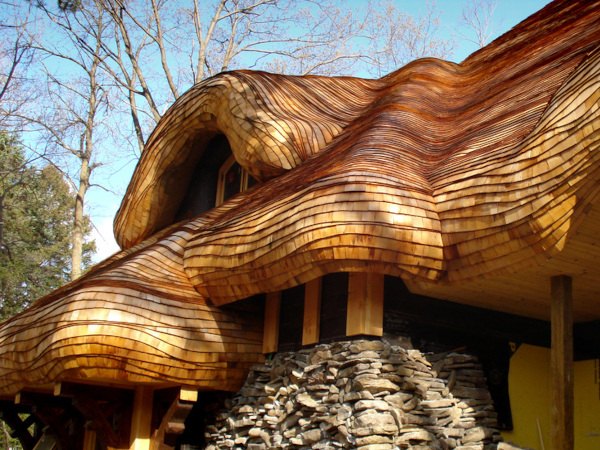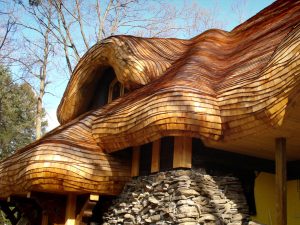“Historic wooden roofs using straight edgegrain heartwood shingles have been known to last over sixty years.” – Sharon C Clarke
Contents
What are roof shingles?
They’re waterproof wooden tiles for exterior cladding of buildings – more typically roofs, but also walls. A shingle is a shaped (profiled or dressed) shake. In other words, a shake is a raw, split piece of wood and a shingle is that same shake shaped to have a slightly different angle (slightly thicker towards the bottom), and a chamfered bottom edge to make it easier to lay on a roof. Roof shakes are a quick, rustic product and roof shingles are a more refined, crafted product.

Historically, shingles and shakes were one of the original natural roofing materials, along with thatch and stone (including slate). Fired clay roofing tiles came along and eclipsed shingles, but they’re now enjoying a renaissance. Traditionally, building materials and styles were vernacular, and the underlying geology and flora of a region determined the type of buildings that people made. So roof slates were first used in Wales, thatch in flat fen and reed areas like Norfolk, stone roofs where there are easily available stone deposits like the Cotswolds, and shingles in wooded areas, especially with oak forests.

Roof shingles and shakes in Britain were traditionally made of oak or sweet chestnut – both of which have a natural durability due to their high tannin content. More recently, western red cedar has been used as a shingle material. It’s not native to Britain, although it can and does grow here. It’s also naturally durable, but won’t last as long as oak or chestnut in the UK climate.
Shingles and shakes are used throughout Europe and North America, and in many other countries where splittable and durable woods are found. Traditionally they are riven (split) by hand along the grain – it’s easier to split wood this way, but also it means that none of the vessels in the wood are cut through (vessels are the vertical tubes within wood that sap travels up). Often, modern roof shingles are sawn rather than split, which means the vessels are sawn through and exposed, allowing water to enter the shingle, thus starting decay earlier.

What are the benefits of roof shingles?
- They can be made locally, by hand – boosting the local economy, reducing the distance that resources have to be transported, and benefiting craftspeople rather than large corporations.
- Shingles have low embodied energy (all the energy required to produce and distribute them) compared to modern mass-produced alternatives (like concrete tiles).
- They create demand for forest products, and so encourage the planting of trees and the maintenance of woodland, which provides habitat for wildlife and improves air quality.

- They contribute to keeping traditional crafts alive.
- They’re biodegradable.
- Like all timber products, they lock up CO2 for their lifetime, so reducing the amount of carbon that would otherwise be in the atmosphere contributing to global warming.
- They have a charm characteristic of natural materials, and give a unique look to buildings that can’t be matched by factory-produced building materials.

What can I do?
You can buy roof shingles, or you can make them yourself. If the average roof is 30-40m², and at around 50-70 shingles per square metre, that will mean up to 2,800 shingles for the average roof. So you might want to make some and buy the rest, or get some friends round to help you make the lot. You can attend a course to learn how to make and lay them, and get some practice. Below is an outline of the process.
Making shingles
You need to get some straight-grain and hopefully knot-free oak or sweet chestnut (in the round). You can get this from a local forester, woodsman or timber yard, or you can check on Coppice Products or similar websites. You need to cross-cut the round timber into 400-450mm lengths, then split the rounds of wood in half, then each piece in half again – splitting radially from the centre like the spokes of a bicycle wheel. To do this you need a froe, and you can make or buy a large wooden mallet. Reject the bark, sapwood and pith as it will rot quickly – only use the durable heartwood.

Then if you wish to dress or shape the shakes that you’ve split – i.e. to make shingles, you’ll need a drawknife and a shavehorse (to sit on, and clamp the piece of wood while you work it). You can make your own shavehorse – you can attend a green woodworking course to find out how (check the course titles – sometimes there are courses specifically on making a shavehorse).
Ftting / laying shingles
Shakes and shingles are fitted to roofing battens (thin strips of wood attached horizontally on top of the rafters). They’re nailed to the battens with roofing clouts (made of copper, galvanised or stainless steel – from your local builders merchant). When you lay a shake or shingle on a roof, you work from the eaves to the apex – i.e. from the bottom up. They’re overlaid, so that at any point, there are three shingles overlapping – i.e. the roof is three shingles deep. At the ridge you overlap the shingles at the top of each side of the roof, and add another layer for more protection.
Here’s more detailed information on installing and maintaining a wood shingle or shake roof.

Specialist(s)
Thanks to Adrian Leaman of Wholewoods for information and Custom Shingles for the main image.
The specialist(s) below will respond to queries on this topic. Please comment in the box at the bottom of the page.

Adrian Leaman of Wholewoods helped Ben Law to build his Woodland House in 2002, and since then has been roundwood timber framing, particularly reciprocal roof roundhouse building, and sharing woodland and woodcraft skills with people from all walks of life. He is a Forest School Leader and works with adults and teenagers on educational projects.



19 Comments
I have a large quantity of oak shingles – probably between 10,000 and 15,000 that are coming off a building on the west coast of Scotland near Gairloch.They are about five / six years old.. They would need to be collected. We are open to offers for them, would like someone to make sure of them. If you would like to know more, please reply to this posting and I will get in touch, Ann
Hi Ann, may well be interested, thanks for posting this. What are the dimensions of the shingles and position of the holes? Doing a self build here for my folks and faced with making at least this number myself. Juan
ooh that’s great news! This is the original spec – 100 x 450mm, tapering from 18mm (base) to 9mm (top) Each shingle should be drilled with two holes to allow for 2 nails per shingle 20mm in from either side, 40mm above the overlap line of the course above.
I will be up on site later this week and can send you some pics if that would be helpful. I think as they are coming off many of the nails are still in them so they would need to be knocked/pulled out. I think we might end up with about 15k use able ones. Are you OK to collect from west coast of Scotland (if you did want them) its a long way from most places!!!
Well, depending on the price and quality, we’d send a lorry up subject to a sample being sent down or a visit.
I’m not sure what the best way to contact you might be so here’s my facebook address and maybe you could add me on there? Not sure if this comments box will allow addresses but here goes:
https://www.facebook.com/juan.edwards.76
Hi Juan, will give you a call
Hi Ann, Do you have any of the shingles left? I need quite a small quantity (approx 6 -8 square metres worth) for a play house I’m building in the garden. I’d be very happy to collect.
Many thanks
Michael
Hi Michael, thanks for getting in touch, I am still working with Juan to set up a suitable time for him to come and pick up – it is pretty chaotic on site right now! I will liaise with him to see whether he might not want them all. Are you ok to bear with me?
Thanks Ann,
I won’t be at the roofing stage for a couple of weeks so am happy to wait. Please just let me know.
Best wishes,
Michael
Michael, hi
Juan’s team is presently on site collecting the shingles, do you still want some? If so, I will see whether or not they want to take all of them, ann
Hi Ann, Do you have any shingles left? We are building a farm shop at Spitalfields City Farm in London and are on the lookout for oak or shingles 🙂
hi,
i am looking for some oak shingles to dress the outside wall of a new extension.
where is the most competitive place to buy them from?
or do you know where any used ones could be found?
best wishes,
sonia
Try looking on this website…www.coppice-products.co.uk
Shingle roofing is the most common roofing system in the valley. Shingle roofing is definitely the best pitched roofing system for the money spent.
Does anyone have any advice on the minimum pitch feasible for chestnut shingle roofing please? We are really keen to use chestnut instead of cedar because the shingles are locally grown and crafted but we are somewhat limited but local planning rules which limit the height of the ridge.
Hey Melanie, good choice chestnut much longer lasting than cedar. 45 deg is good to aim for and as the pitch goes down so does the life of the shingles. You can lay then on 20degrees if you have to it’s just that they won’t last as long.
Would You Be Interested In Buying Uk Made Shingles?? As An Example We Produce A Good Quality Tapered Shingle In Sequoia ( Which Will Last Longer Than Cedar) For £45/ M2 Based On 1/3 Cover On The Tile Thats An Inclusive Of Vat Price .. And We Can Drop Ship In Bulk For You…
Our Flat shingles are cut to 300, 400 or 450 mm by 10mm ( or custom order length) and start from £10 per actual M2
We also produce ridge tiles cheaper then the imported ones…
please feel free to call to discuss
Would You Be Interested In Buying Uk Made Shingles?? As An Example We Produce A Good Quality Tapered Shingle In Sequoia ( Which Will Last Longer Than Cedar) For £45/ M2 Based On 1/3 Cover On The Tile Thats An Inclusive Of Vat Price .. And We Can Drop Ship In Bulk For You…
Our Flat shingles are cut to 300, 400 or 450 mm by 10mm ( or custom order length) and start from £10 per actual M2
We also produce ridge tiles cheaper then the imported ones…
please feel free to call to discuss
Thanks for this post! As a roofer myself, I’m yet to be more knowledgeable about different kinds of roofs. I’m looking forward to reading more articles about roofing. https://www.cairnsroofingservices.com/
Thanks for this post! As a roofer myself, I’m yet to be more knowledgeable about different kinds of roofs. I’m looking forward to reading more articles about roofing. https://www.cairnsroofingservices.com/